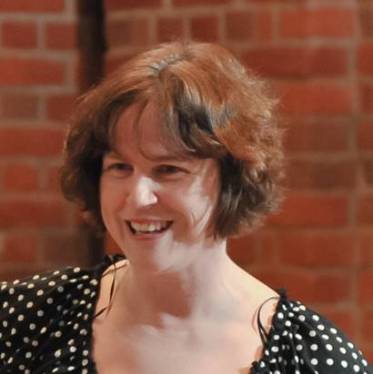My guest post this week has been written by piano teacher and author Karen Marshall. Karen feels passionately about keeping students engaged in their piano studies, with emphasis on enjoyment, so they want to continue their piano playing. I asked her what elements she considered most important when teaching at the intermediate level (approximately Grade 3 – 5). Over to Karen…
 The intermediate stage of learning the piano – and indeed any instrument – is a notoriously tricky period. Many teachers may find students dropping off, losing interest and quitting lessons. I’ve been teaching now for over 25 years and it could not fail to come to my attention that these stages of learning were some of the most difficult to progress through.
The intermediate stage of learning the piano – and indeed any instrument – is a notoriously tricky period. Many teachers may find students dropping off, losing interest and quitting lessons. I’ve been teaching now for over 25 years and it could not fail to come to my attention that these stages of learning were some of the most difficult to progress through.
There are multiple reasons for this, but I believe it is often at least partly due to increased school work (leaving less time to practise), at the same time as music becoming considerably more complex. Students who have a good ear and have previously been able to memorise music will start to struggle to do this with the longer repertoire. Added to that, frustrations mount as music becomes more technically and musically demanding, resulting in slower progress.
My solution to these problems was to come up with an intermediate curriculum for my students that would help to develop their musical understanding and provide a holistic learning experience. But I also realised that my students required variety, the opportunity to be creative, and a continual sense of achievement. If these elements are combined with key theory, technical development, and carefully chosen repertoire, I found that note-reading will be improved, technique and musicality developed and students will gain a greater understanding of what they are learning.
 The Intermediate Pianist is an amalgamation of my life’s work, tailoring this holistic approach for use with Grade 3 to 5 level students. It is a series of three books that has emerged from years of working with these students, aided by many attractive compositions by Heather Hammond. It is, in essence, a music curriculum that piano teachers can use to fit their teaching style, either by working through each chapter in lessons, or by getting students to use it at home.
The Intermediate Pianist is an amalgamation of my life’s work, tailoring this holistic approach for use with Grade 3 to 5 level students. It is a series of three books that has emerged from years of working with these students, aided by many attractive compositions by Heather Hammond. It is, in essence, a music curriculum that piano teachers can use to fit their teaching style, either by working through each chapter in lessons, or by getting students to use it at home.
Co-author Heather Hammond and I have paced the books to take into account varying time students have to practise. We made sure that the music deliberately spanned a range of difficulty levels and styles, so some pieces can be learnt in just one or two weeks, whilst others are more challenging. This approach has been highly successful in ensuring my students didn’t give up the piano, and very luckily I was able to get this curriculum published. Here’s a quick look at the different elements:
To provide variety and understanding
25 Styles of music explained with definitions and activities over three books. Including March and Lullabies, Swing and Boogies; Polka and Baroque Dance Suits, Four chord Pop and Reggae; Latin and Theme and Variations, Impressionism and Minimalism.
To provide opportunities for creativity and understanding
Musicianship activities included throughout from playing by ear to transposition, listening activities to recognising cadences. Theory is included in a creative and attractive way with word searches and quiz activities.
To provide pace and ‘quick wins’
Quick learn material for sight reading – lots of easier material is included so students will have enough time to complete the whole book and experience lots of styles, keys and improve their sight reading. Pieces move forward and backwards in levels for consolidation.
To provide understanding
Technique – All keys’ scales and arpeggios are covered up to five flats and five sharps along with carefully selected technical exercises or repertoire to develop key technique.
To keep students inspire using the repertoire of great composers
Repertoire – Core repertoire has been selected from Bach’s Anna Magdalena Note book and his Two Part Inventions, Schumann’s Album for the Young, Tchaikovsky’s Children Album, Clementi Sonatinas Opus 36, Burgmuller’s Opus 100, Chopin’s Preludes and Bartok’s For Children. This is combined with new composition and arrangements or famous classical music from Beethoven’s 7th Symphony to the Flower Duet by Delibes, Howard Goodhall’s QI theme and Por Una Cabeza Tango.
If you’re feeling inspired by The Intermediate Pianist, you can find out more and keep up to date with Karen’s upcoming titles by joining Faber Music’s mailing list, by clicking here.
You can purchase The Intermediate Pianist from all good retailers, or from Faber’s website, here.
My Publications:
For much more information about how to practice piano repertoire, take a look at my two-book piano course, Play it again: PIANO (Schott). Covering a huge array of styles and genres, 49 progressive pieces from approximately Grade 1 – 8 level are featured, with at least two pages of practice tips for every piece. A convenient and beneficial course for students of any age, with or without a teacher, and it can also be used alongside piano examination syllabuses too.
You can find out more about my other piano publications and compositions here.
from Melanie Spanswick https://melaniespanswick.com/2018/05/21/teaching-the-tricky-intermediate-stages-by-karen-marshall/
No comments:
Post a Comment